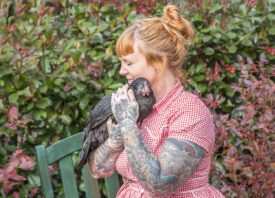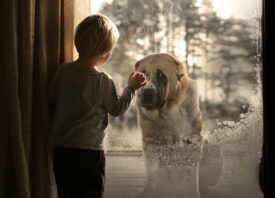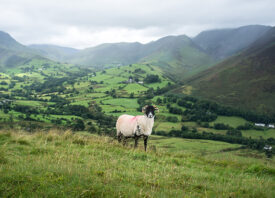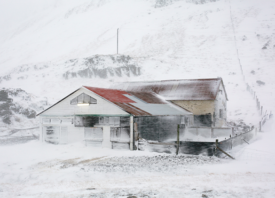Search this site
Soulful Photos of Animals Saved from Slaughter or Neglect

Scout

Shy Girl
“Scout the sheep is my muse,” the photographer Janet Holmes tells me. As a volunteer at the Catskill Animal Sanctuary in Saugerties, New York, she’s developed a bond with many of the rescued farm animals, but none quite compare to Scout. “Sheep can recognize human faces, and she seems to remember me,” she continues. “Almost every time I visit, she comes over to say hello and asks for a back scratch just the way a dog does, by nudging her head under my hand. She’ll lean her weight against my leg and even rest her head on my shoulder.”
Scout’s trusting nature is a testament to her strength. When she was a young lamb, Scout was one of a group of sheep found starving in a backyard slaughterhouse. Many of the animals at Catskill Animal Sanctuary have similar pasts; some come from illegal farming operations, and others were headed to slaughter. One cow was saved just in the nick of time when a mother and daughter stepped in and bought him before he could be put up for auction, and two pigs were surrendered when their farmer-owner had a change of heart and decided to leave the farming industry.
For these animals, CAS is a second chance and often a forever home; in fact, one horse even refused to leave when someone tried to adopt her (she still lives at the sanctuary). Here, they all receive individual care based on their specific needs. Some live in large paddocks with their friends, and others roam around and mingle with the visitors. All of them have the choice to do as they wish. “In the summer, you’ll find goats relaxing under cool trees, and the pigs will be lounging in the mud, which helps them cool down and protects them from the sun,” Holmes explains.
The photographer herself stays at the Homestead, a guesthouse at the Sanctuary where she can rest and enjoy vegan meals. “I love to listen the Sanctuary wake up, and that moment when I walk down the hill to the barns listening to the roosters crow and the sheep and goats bah feels cleansing,” she admits. “I spend long days on the Sanctuary grounds, watching the animals and inviting them to get to know me on their terms, not mine, before I photograph them. Some of them are quite interested in the photographic process, which presents some challenges. Chickens like to peck shiny surfaces, and the cows, goats, and sheep will lick my lenses, so I protect my camera with a filter and keep a bag stocked with lens wipes. And the goats and pigs will try to open my camera bag looking for treats.”
Holmes never takes a single funny, heartwarming moment with Scout and her fellow residents for granted. She understands that for every animal rescued, there are countless others who won’t escape a system that profits from their suffering. Farm animals raised for human consumption and entertainment don’t have the freedom to explore, play, and form bonds with others, but CAS offers a kind alternative to a cruel world. In this special place in New York State, animals and humans exist side-by-side as confidantes and companions. In the end, animals are often our gateway to rediscovering our humanity. As the Sanctuary founder Kathy Stevens told Holmes, farmed animals can be our “teachers and friends,” if only we dare to listen.
We asked the photographer about the work she’s done at CAS. You can learn more about the Sanctuary here. Make a donation to support the care of their animals here.

Freddy and Travis
What’s the most powerful memory you have from your early days at Catskill Animal Sanctuary?
“On my first day at the Sanctuary, I wandered the grounds and met so many intriguing animals and friendly people. In the afternoon, I made a (not-very-good) portrait of a “broiler” turkey named Daisy. Broiler turkeys are bred to grow very large very quickly and then be killed at a few months old so that we can eat them for Thanksgiving or Christmas dinner.
“I met her as an adult, when she already was having some difficulty carrying her heavy body on legs too thin to support herself. She was standing in the shade under a sign when I photographed her, and the sign said, ‘Be the change you wish to see in the world.’
“When I got back to the Homestead and started reviewing my photos from the day, I stopped when I got to that image. That was it for me. I said to myself, ‘Yes. Yes, I need to become vegan because that is the only thing that is consistent with my values. I want to help individuals like Daisy by supporting the Sanctuary. I want to use my skills as a photographer (and my written advocacy skills as a lawyer) to try to change hearts and minds.’ My first visit to CAS, and creating that portrait of Daisy, changed the trajectory of my life.”

Daisy
What does daily life look like for some of the animals at the sanctuary?
“In my experience, farmed animals are a lot like our companion animals and enjoy many of the same things. They love to eat, and they especially like to eat food they’re not supposed to have. At certain times of year, there are special treats (such as post-Halloween pumpkins and watermelon in the summer). They love to doze in the sun, and then find cool places to retreat. The goats climb and play, so they have swings, bridges, and jungle gyms. The pigs and calves will play with balls. And the horses love to run in their fields.
“Many of the residents groom each other, and most enjoy spending time with other members of their flock or herd. They can have close friendships with individuals (of the same or different species), and you’ll often see them seeking out their friends and hear them calling out if they don’t know where their animal friend is. Some of the residents are especially curious, and they will try to figure out unhook latches, open containers, or get around obstacles.
“To varying degrees, they seek out human contact. Sometimes, they will communicate to you very clearly what they want. For example, Bartleby the goat will walk over and stand on your foot until you scratch his head and back for long enough. He’s a little guy so it doesn’t hurt.”

Bartleby
Can you tell us the story of one of these animals?
“Buddy is an Appaloosa horse, a breed of horse that is prone to blindness. When Buddy went blind, he started to have panic attacks, and his owners didn’t know how to care for him. They surrendered him to Catskill Animal Sanctuary, which has experience in rehabilitating and caring for blind animals. Founder Kathy Stevens and the staff worked with him to make him feel comfortable and safe in his new home. Other blind residents and special needs animals also helped him feel better.
“A few years after he arrived at CAS, his blind eyes started to cause him increasing pain, and so he had surgery to remove both eyes completely. Despite his blindness, however, Buddy moves around his paddock with confidence. Especially in the morning, after his caregivers walk him from the main barn to his field, he likes to canter around the large field with his friends.”

Buddy
Have you experienced or witnessed a special bond between an animal and a human at CAS?
“I love watching Violet the goat with her ‘mom,’ Kellie Myers. Violet was the runt in a litter of triplets born to a goat rescued with about 150 other animals in 2015 from a makeshift slaughterhouse associated with a ‘farm-to-table’ restaurant. Some of the rescued goats were pregnant, including Violet’s mother, and they were very sick and weak. Violet’s mother would have found it difficult to feed all three of her babies, so it isn’t surprising that she rejected her.
“Staff scooped up Violet, and caregiver Kellie took her home to provide 24-hour care until Violet grew strong and healthy enough to live full-time at the Sanctuary. You can see a video here made by staff at the Sanctuary and featuring Kellie with Violet when she’s only a few days old. You can already see the loving bond between them. Violet has grown into a sassy teenager, but she still views Kellie as her mother.

Violet
Why do you think farmed animals are so invisible in today’s culture?
“I think farmed animals are invisible to many people for several reasons. First, most humans do not want to harm animals, but they have been conditioned to believe that using animals for food, clothing, and other products is ‘normal, natural, and necessary’ (Melanie Joy). It is stressful to hold these contradictory values at the same time. To address that stress, people unconsciously or consciously take steps to avoid thinking about the harm that we cause animals.
“The businesses that supply us with animal-based food, clothing, and other products recognize, at some level, that we are uncomfortable causing harm to animals. Naturally, they take steps to hide from our view the process of turning animals into products. They do this in a very physical way, by constructing farms and processing plants that hide the violence. And urbanization and the industrialization of animal slaughter exacerbate the situation. We don’t need as many people to produce the animal-based products that we consume, and so fewer people live near the places where animals are raised and slaughtered.
“Businesses also hide farmed animals through labels and advertising. We eat bacon, not pigs. In restaurants, we choose a ‘protein’ to top our noodle bowl, and that protein is pork, beef, or seafood (not pig, cow, or fish). Businesses also use labels to give us a false comfort that the animals that they exploit on our behalf are treated well. We are told that they are ‘free-range,’ pasture-raised, happy cows and chickens. And the products are decorated with cartoons.”

Clarice
What can be done to change the way we think about animals?
“I don’t have the answer to how we change the situation to make the world a better place for animals. Speaking from my own experience, I think it is important to create opportunities for people to experience animals as individuals – individuals who think and feel in ways that are not that different from the ways humans and their pets think and feel. Those experiences can be multi-sensory ones, like visiting a farm sanctuary. They can be visual ones, like observing animal portraits, watching movies or scrolling through social media feeds that feature rescued, farmed animals.
“I also think there is a need for positive imagery, like many of the portraits that I create of rescued animals. Some people tell me that my photographs help them think about, and identify with, farmed animals without immediately triggering feelings of guilt or dread. These kinds of images help them become sensitized to farm animals as individuals, and that makes them more open to learning about how farmed animals are exploited.
“We also need to support individuals and organizations who document the exploitation and abuse that animals suffer and challenge the “Ag-Gag” laws that prevent such transparency. Photographer Jo-Anne McArthur has comprehensively been documenting humans’ relationship with animals for decades and I highly recommend her books, We Animals and Captive. There is a new documentary called Dominion with stunning, horrible footage of how we treat animals. I don’t we should force ourselves to watch this kind of material regularly or at length, but I also think we sometimes need to share this imagery and these stories to shake people out of their complacency.
“To stop exploitation of animals, we need to challenge ourselves and the systems that normalize the use of animals. Not everyone is going to go vegan overnight (I didn’t), and no one is perfect. But people can take time every day to reflect on the specific choices they make and try to be honest with themselves about whether their actions are aligned with their values.
“For example, you can read labels and picture the individual behind the product before you buy it. Exercise your curiosity to find out how animals are treated in the production of your food, clothing, and cosmetics. Ask restaurants and stores for alternatives. Speak to your family, friends and colleagues about their choices, and subscribe to a few vegan blogs or news channels to become better informed.”

Sadie
What motivates you to continue this work, even when it gets hard?
“For many years I was afraid to get involved with animal rescue because I didn’t think I could handle the heartbreak. And, in fact, I have experienced a lot of heartbreak since I started volunteering with animal rescue groups. I have fallen in love with animals who died. Some even died in my hands as a caregiver at the Wild Bird Fund. And at least every couple of weeks, I learn from a rescuer that one of the animals I have photographed has passed away.
“Despite the heartbreak, I continue because I have also experienced so much joy and love since I started volunteering with rescue groups. I have seen miracles. I have watched injured, starving, lonely, and fearful animals heal and learn to enjoy their world and trust humans. I’ve comforted animals, and they have comforted me. I’ve been nuzzled, nosed, licked, hugged, and kissed.
“I marvel at the animals’ resilience and their capacity to recover from physical and emotional damage. I carry with me the memory of how they moved, how they felt in my arms, and how they looked at me. My heart is full, and it is getting bigger.
“I continue with this work because I want to support the caregivers, who experience very high rates of stress and burnout in their work. I make portraits of animals so that they have tangible mementos of these individuals who touched their lives. I also try to provide financial assistance, by donating my services, photo-based products and some of the profits from sales of prints and books to rescue groups, like CAS, and individual caregivers.
“And finally, I continue with this work because I hope that I can make a difference in the lives of individual animals. If my photographs can influence one person to change their behavior and reduce their consumption of animal products, it is worth all the heartbreak.”

Bruce

Scout and Zeke
All images © Janet Holmes



